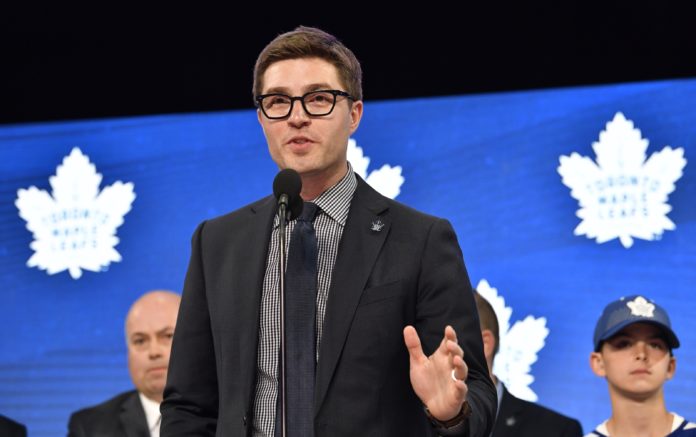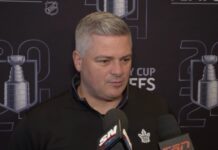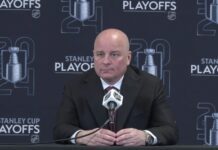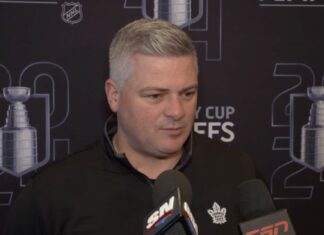
In our offseason game plan series so far, we have evaluated the Maple Leafs’ roster as it currently stands – both the depth and the main core. While the point of this series isn’t to predict the exact moves the Leafs will make this offseason, we will consider various possibilities.
When we looked at the team’s remaining cap space, there were obvious paths available to clear salary and alter the roster around the core. We recently saw an example take place with Tampa Bay and Ryan McDonagh; the Lightning continually shed salary every offseason to focus on their core and surround them with the best options as they see fit (see: re-signing Nick Paul and, presumably, Ondrej Palat).
For the Leafs, there are a number of young players on cheap, entry-level contracts who would benefit both player and organization if they were in the lineup daily for the first half of the season before making an assessment in regards to the playoff roster.
In this type of scenario, it could potentially give the Leafs just enough cap space to swing on a player who actually moves the needle as opposed to only bargain-bin hunting (think players like Andrew Copp or Nino Niederreiter, while assuming Val Nichushkin will be too pricey). A number of young players competing for roster spots against each other, rewarding the winners with opportunities to stick in the lineup, and signing a legitimate NHLer of note to complement the core in place is a viable plan throughout the season and playoffs.
The alternative plan is signing a number of players on smaller-dollar contracts and hoping to hit on a few, much like last season. While it’s a fine-enough strategy to extract hidden value, there’s a reason these players are bargain finds – hardly any of them are difference makers when the chips are down. Even Michael Bunting, who admittedly was banged up (then again, who isn’t in the playoffs?) was not particularly effective in the postseason. Adding a player with some established pedigree to mix into the group – as opposed to a bunch of gambles – would really provide a different outlook and more options for Sheldon Keefe heading into the season.
This brings us to the upcoming NHL draft. The Leafs have three picks going into it: a first, a third (originally Winnipeg’s), and a seventh. In 2021, they also drafted three times. Needless to say, they can’t keep drafting less than half a full draft class, even if Matthew Knies does look like a player with serious potential. Both quality and quantity are important, and six selections in two years will be felt at some point.
It’s one thing to aggressively buy at the deadline and win playoff series, but to continually buy, lose out in the first round, and sit at the bottom of the league in draft selections is not viable long term. No team drafted less often than the Leafs last year (three times), and Toronto is currently tied with Calgary for the fewest number of draft picks heading into the 2022 draft, although they do own their first-round selection (Florida and Colorado aren’t slated to draft until the third round).
Of course, the Leafs can add more picks. That’s where the strategy of this draft will be interesting to watch – there are a few ways the Leafs can get there should they make it a real priority this week (and my guess is that they will).
The most viable option – which helps them in a number of ways – is trading players for draft picks. It clears the cap room to change the makeup of the bottom six while adding draft picks to the 2022 class.
The most obvious candidate for a trade is Alex Kerfoot, who is coming off a career season, has one year left on his contract, and is making $3.5 million on the cap but just $2.7 million in actual salary (note: it drops to $750k after his signing bonus is paid). He’s a versatile, low-maintenance player for the Leafs who wears a lot of hats (penalty killer, sometimes plays on a scoring line, sometimes plays on a checking line, both a winger and a spot-duty center). However, he isn’t a play driver, and he’s also not much of a scoring threat (he scored 13 goals last season).

Last year, much worse players than Alex Kerfoot were traded for reasonable draft-pick returns: Jason Dickinson netted the Dallas Stars a third-round pick; Adin Hill fetched the Arizona Coyotes a second-round pick and a goalie prospect, and Ryan Graves netted the Colorado Avalanche a second-round pick and prospect.
Coming off a career year, there is no reason to think the Leafs couldn’t move Kerfoot for two draft picks, one of which is a second-rounder. That move alone would suddenly give the Leafs five picks, including selections in the first, second, and third rounds.
There are other trade candidates, too. Do they want to extend and pay Pierre Engvall or go in a different direction? Do they want to use Jake Muzzin’s cap allotment elsewhere and also clear a path for Rasmus Sandin to stick in the lineup full-time?
In Part 1, we noted the need for the Leafs to make room for spots in the lineup for young players, and it’s now been reported that the contract negotiation is hitting a snag due to uncertainty about Sandin’s spot in the lineup. Kyle Dubas could take the cap space and use it elsewhere.
Only the Leafs really know the reality of Muzzin’s health situation. If he is actually healthy – as in they have no reason to think he won’t hold up better this season – he does offer something that no one else on the Toronto blue line really provides. Nobody would really question an in-form and healthy Muzzin, but his health uncertainty leads to all sorts of question marks.
Alternatively, the Leafs could move draft capital from upcoming drafts to increase their stockpile in this year’s draft. They currently own their first, third, fourth, fifth, and sixth-round selections in 2023. It would feel like a case of robbing Peter to pay Paul, but if they wanted to kick the picks deficit down the road and make it a future problem, they could buy into rounds three to five in this draft.
This does feel like a draft that will be littered with mistakes. It’s a Covid draft class comprised of prospects who have experienced significant disruptions in their development. It’s easy to picture talented players falling through the cracks.
In that same vein, the Leafs could look to trade down. The only pick that could fetch them notable value is their first-round selection, which falls at 25th overall. It’s late enough in the first round that trading down is generally viewed as the smart play in terms of extracting additional value. Any number of draft-pick value charts would tell us the difference between the 25th pick and – let’s say – the 40th pick is negligible, and if a team can move down while adding extra picks in the process, it’s worth exploring.
At the end of the day, if the Leafs show up at the draft in Montreal this week and pick only three times – after drafting three times last summer and winning nothing – it would be a tough pill to swallow. A combination of shedding some salary (Alex Kerfoot) and trading down from 25 to net two picks of note would provide the Leafs with the capital to make some noise in this draft and stockpile picks and prospects.
Last year, Nashville traded down from 27 for picks 40 and 51. A little higher up, Minnesota traded down from 20 to 22 and picked up a third-round selection in the following draft in the deal. It doesn’t have to be a massive drop-down in pick selection, but they could add a selection of note in the process.
Anaheim owns picks 42 and 53. Arizona holds picks 27, 32, 34, 36, 43, 45, 67, and 131. Chicago currently has 38 and 57. Those are just a few examples. If there is an appetite on the other side to trade up, the Leafs should have options to potentially add multiple picks in the second round (with a potential Kerfoot-type trade netting them another one).
Historically, the Leafs have unearthed a lot of value in round two under Kyle Dubas. 2018 second-rounder Sean Durzi just enjoyed a very strong rookie season in LA. Nick Robertson has flashed promise already. Matthew Knies and Roni Hirvonen are, if nothing else, promising prospects whose stock has risen since their draft years. It is fair to call it a money round for them.
To me, a successful draft weekend for the Leafs includes shedding salary and adding more draft picks. If they somehow pull off a trade to bring in a quality NHLer? Even better. If Leafs brass shows up, makes three picks, and flies home, it would be an underwhelming draft weekend in Toronto.




![Sheldon Keefe Post Game, Leafs 3 vs. Bruins 2: “I loved [the Matthews] line, and I loved a lot about our game all the way through the lineup” Sheldon Keefe, Toronto Maple Leafs post game](https://mapleleafshotstove.com/wp-content/uploads/2024/04/keefe-pg-game-1-218x150.jpg)

























![Sheldon Keefe Post Game, Leafs 3 vs. Bruins 2: “I loved [the Matthews] line, and I loved a lot about our game all the way through the lineup” Sheldon Keefe, Toronto Maple Leafs post game](https://mapleleafshotstove.com/wp-content/uploads/2024/04/keefe-pg-game-1-100x70.jpg)



